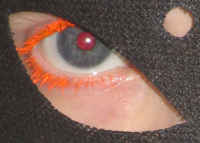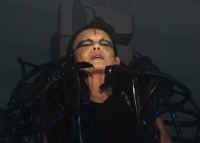Do Androids Dream of Balenciaga SS29?
Robbie Barrat Imagines a Future in Which the Creative Director is a Computer
- Interview: Arabelle Sicardi
- Images/Photos Courtesy Of: Robbie Barrat
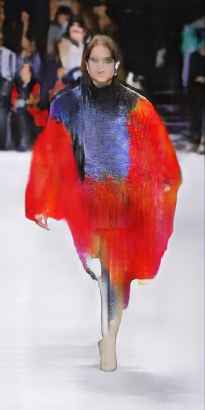
How do you teach a robot to create? Can it design beauty? Has a nineteen-year-old stumbled upon the next stage of fast fashion: a version of the industry that doesn't necessarily need a human touch at all?
Robbie Barrat (@DrBeef_) is a prodigy. I hate introducing him like that—it’s reductive—but he is definitely at least that. Being a nineteen-year-old genius working in a research lab at Stanford University certainly lends itself to the qualification. He went from high school in West Virginia to working in San Francisco at NVIDIA, after his Kanye West-emulating neural network (that writes rap songs based on the latter’s entire discography) caught the attention of an exec. He has yet to attend college as a student, though he does research at Stanford University’s Center for Biomedical Informatics Research and guest lectures for Continuing Studies classes on artificial intelligence. Oh, and he’s self-taught.
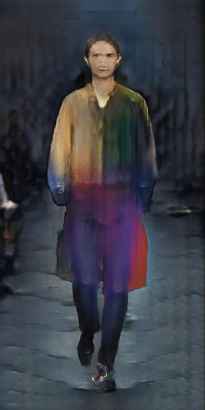
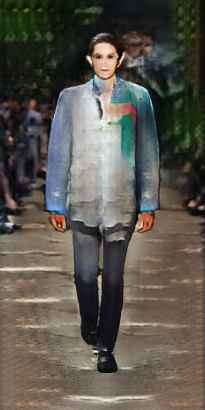
He is more than smart—he’s one of the most exciting artists working with artificial intelligence right now. And his skill set spans industry: besides his Kanye West AI, he's created a guide on how to use plant-based electricity to create generative art and an AI that writes piano melodies in the likeness of Bach. And the AI-generated painting that just sold at Christie's for over $400,000? The artists borrowed Barrat's code. He’s also written an AI that generates ur-Balenciaga—lest you get litigious, it’s not really a bootleg, just possibly the nerdiest love-letter to a brand a fan has ever made.
Dystopian survivalists need not worry. Barrat's Balenciaga AI is a continual work of conversation, experimentation, and curation—just like analog designing so often is. The silhouettes are legitimate, but the gradients are unearthly and fragmented, with often no delineation between where the “human” model stops and the clothing begins. Sometimes it eerily perfects variations of what's really gone down the runway and sometimes—the best times—it ekes out the most bizarre and joyful spacey surprises. The results of the AI are weird and, yes, beautiful. They are Balenciaga, if you threw all their collections into an atomizing time machine and asked an alien on the other side to reconstruct the originals from the scrambled remains. Alternate-reality Balenciaga. Maybe future Balenciaga. Demna, are you listening?
Arabelle Sicardi
Robbie Barrat
There are so many designers and you chose Balenciaga. Is Balenciaga your favorite designer?
Absolutely. When you boil their products down, you could say this speed-trainer is just like a sock with a shoe sole. The double-shirt is just two shirts. It all sounds ridiculous, ideas that just should not happen, but they take those ideas and refine them and make them work without watering them down. It's a weird Dada thing that you spend $1,000 on. The price is a huge part of my fascination with it. I'm not saying it's not worth it, but I think that really adds to the allure, and to my curiosity. I really like AI, and apply it to art, so I figured why not just mess around with AI and Balenciaga and see what happens?
How many Balenciaga images have you put into your initial data set and how have you been adjusting it? You're doing runway video too, right?
I like those, but it feels more like a technical trick instead of something aesthetically valuable or an outfit that one could wear, because the details aren't really that clear. So I've laid off of the video. That's a completely different data set than what I'm using for the still images. Have you seen the images that are the pose of the person, that it extracts?
That was the first version of the process that you were developing.
Yeah. There's this network from Facebook that comes pre-trained to identify where all the people in an image are. It generates that picture of green stick figures. That's called dense pose. I'm using that to extract a pose and then trying to teach the neural network to go from pose, back to Balenciaga. It's passing it through a bottleneck that you can't really hope to fully reconstruct it from, and there is information loss. You're trying to teach the network an impossible task. What’s interesting is what it creates to try and fulfill that, which are the weird AI-generated Balenciaga artifacts.
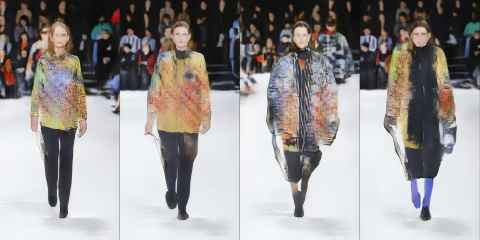
"Maybe a designer could hit a button, and it would generate a new outfit."
I was working on AI learning and pattern recognition at a social media company [we’ll call it… Chirper] and there I trained AI to recognize when a river's a river, etc. But you’re doing a step beyond simple recognition and categorization. You're getting AI to create its own versions of things.
Yeah, it's approaching the same problem, except the other way around.
It side-steps the ethical dilemma that I always had with pattern recognition software, too. Instead of teaching something that could be used to survey marginalized people, you're just creating cool stuff. All of the models in these generative software have no actual faces, so it’s not learning faces and assuming the bias we typically codify into face recognition software.
The Department of Defense is always contracting these huge companies like Google to use their existing machine running software and they use it for something awful like drones. But working with AI and generative art is nice because people can't really misuse your software or your results. I totally agree.
I have had a few people message me very concerned about my work, though. They think that it's going to automate away artists. It's really not. AI is going to be good for artists. Instead of automating them away, I think we're going to get a ton of really sick artists' tools that are powered by machine learning and AI. It is augmenting artists' creativity. Maybe a designer could hit a button, and it would generate a new outfit. They could look through those and get an idea to implement in their own practice.
A lot of work right now is self-referencing in a way that already feels algorithmic. When you actually put an algorithm in your hands, it forces you to create versions and derivatives. It draws conclusions you wouldn’t have considered, because it lacks the context that may inhibit you. It's helping forward the process along without devaluing it. Maybe this is a completely different version of fast fashion.
Like surreal, infinite fashion. There's no limit to how many outfits this AI model can generate. A lot of them might be highly similar, but you can generate infinite an amount. It has the potential to be infinitely fast fashion. Although I wouldn't want that, because fast fashion sucks.
It would also be impossible to replicate any of these in real life perfectly right now. The coolest thing about this AI is the weird, textural detail it illustrates.
That was what was disappointing when we were choosing a sweater example that we wanted to prototype. The textile technology isn’t there yet. Or at least, I don’t have access to it.
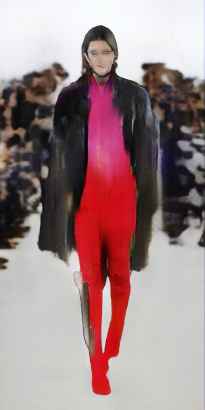
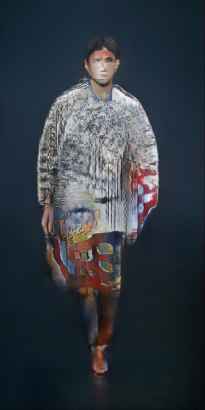
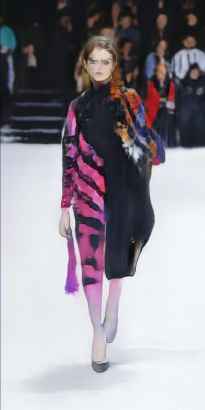
Some of the other things the AI attempts have already been done in different ways, by human beings. Like the weird red bleeds remind me of other [non-Balenciaga] work. Raf Simons' Sterling Ruby collection for Dior. Some of the galaxy-esque prints are reminiscent of Christopher Kane. Are there any pieces that remind you of designs that already exist, that aren't Balenciaga?
Well, that is hard for me to answer, because all of the fashion that I read about and look at is Balenciaga.
[Laughs] That’s why this is so fun to me. You don't have to be a fashion expert to create this. You're coming at it from a different vantage point.
A big part of my role in this collaboration with the machine is really that of a curator, because I'm curating the input data that it gets, and then I'm curating the output data that the network gives me and choosing which results to keep, and which to discard. All of the results are pretty good. A lot of them look like normal Balenciaga, and I don't really consider that the point. The point is to train the network on Balenciaga and see if it will generate something different, to see if it will misinterpret Balenciaga.
Mistaking it into something entirely different.
Yeah, exactly! There are some super cool examples of that, like with the shin bag. A human at Balenciaga designed normal bags, right? And the people walk down the runway carrying the bags in their right hands. The network saw this and misinterpreted it, because it doesn't know what bags are for. It doesn't know that people carry things in bags. It doesn't know that you need a handle to have a bag, and it always sees bags
It creates a completely different conversation. That particular example is so interesting to me, because that pant leg is also red at the point of connection, the point of body heat. So it's highlighting the point of relationship, not just being a bag.
Dude, yeah.
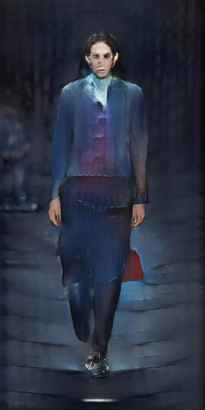
You have all of these results and you try to pick specific ones. What qualifies a result as a success to you?
I don't know if I consider any of the results that I've posted so far to be successes, but what makes the results stand out to me are novelty, variance, and distance from the actual Balenciaga collection.
I am done with the questions besides the obvious one: if Balenciaga knocked on your door and asked to collaborate, what would you say?
Oh my gosh, yes. Are you kidding? I mean, I'd have to. You can't say no to that.
- Interview: Arabelle Sicardi
- Images/Photos Courtesy Of: Robbie Barrat

